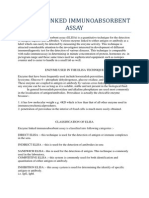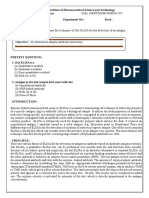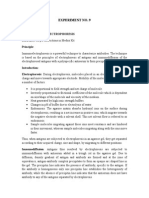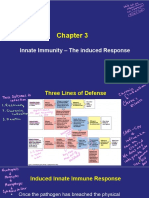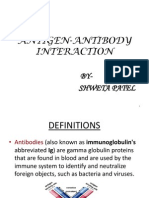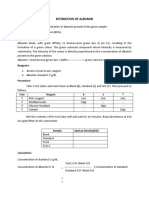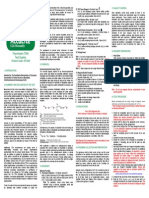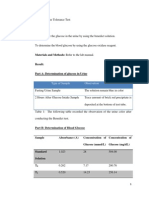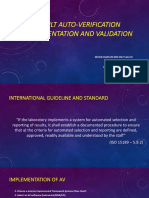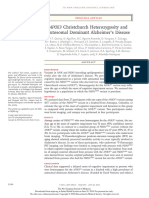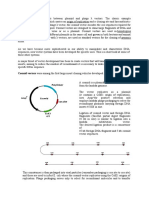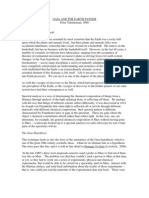0 ratings0% found this document useful (0 votes)
152 viewsComplement Fixation Test تقرير د-حيدر-محول
Complement Fixation Test تقرير د-حيدر-محول
Uploaded by
YASMINAThe complement fixation test uses sheep red blood cells coated with anti-sheep antibody to detect the presence of antigen-antibody complexes. Patient serum is mixed with a known antigen, and if antibody is present it will bind the antigen to form complexes that deplete complement from the solution. Sheep red blood cells are then added along with complement; if complement was previously depleted, the cells will not lyse, indicating a positive result for antibody in the patient's serum.
Copyright:
© All Rights Reserved
Available Formats
Download as PDF, TXT or read online from Scribd
Complement Fixation Test تقرير د-حيدر-محول
Complement Fixation Test تقرير د-حيدر-محول
Uploaded by
YASMINA0 ratings0% found this document useful (0 votes)
152 views5 pagesThe complement fixation test uses sheep red blood cells coated with anti-sheep antibody to detect the presence of antigen-antibody complexes. Patient serum is mixed with a known antigen, and if antibody is present it will bind the antigen to form complexes that deplete complement from the solution. Sheep red blood cells are then added along with complement; if complement was previously depleted, the cells will not lyse, indicating a positive result for antibody in the patient's serum.
Copyright
© © All Rights Reserved
Available Formats
PDF, TXT or read online from Scribd
Share this document
Did you find this document useful?
Is this content inappropriate?
The complement fixation test uses sheep red blood cells coated with anti-sheep antibody to detect the presence of antigen-antibody complexes. Patient serum is mixed with a known antigen, and if antibody is present it will bind the antigen to form complexes that deplete complement from the solution. Sheep red blood cells are then added along with complement; if complement was previously depleted, the cells will not lyse, indicating a positive result for antibody in the patient's serum.
Copyright:
© All Rights Reserved
Available Formats
Download as PDF, TXT or read online from Scribd
Download as pdf or txt
0 ratings0% found this document useful (0 votes)
152 views5 pagesComplement Fixation Test تقرير د-حيدر-محول
Complement Fixation Test تقرير د-حيدر-محول
Uploaded by
YASMINAThe complement fixation test uses sheep red blood cells coated with anti-sheep antibody to detect the presence of antigen-antibody complexes. Patient serum is mixed with a known antigen, and if antibody is present it will bind the antigen to form complexes that deplete complement from the solution. Sheep red blood cells are then added along with complement; if complement was previously depleted, the cells will not lyse, indicating a positive result for antibody in the patient's serum.
Copyright:
© All Rights Reserved
Available Formats
Download as PDF, TXT or read online from Scribd
Download as pdf or txt
You are on page 1of 5
Complement Fixation Test
It is a classic method for demonstrating the presence of antibody in patient serum.
It is based on the principle that antigen-antibody complex fixes the complement. As
coupling of complement has no visible effects or changes, it is necessary to use an
indicator system consisting of sheep RBC and coated with anti-sheep RBC antibody.
Complement lyses antibody coated RBC.
The complement fixation test consists of two
components.
The first component is an indicator system that uses combination of sheep
red blood cells, complement-fixing antibody such as immunoglobulin G
produced against the sheep red blood cells and an exogenous source of
complement usually guinea pig serum. When these elements are mixed in
optimum conditions, the anti-sheep antibody binds on the surface of red
blood cells. Complement subsequently binds to this antigen -antibody
complex formed and will cause the red blood cells to lyse.
The second component is Test System (A known antigen and patient serum
added to a suspension of sheep red blood cells in addition to complement).
These two components of the complement fixation method are tested in
sequence. Patient serum is first added to the known antigen, and
complement is added to the solution. If the serum contains antibody to the
antigen, the resulting antigen-antibody complexes will bind all of the
complement. Sheep red blood cells and the anti-sheep antibody are then
added. If complement has not been bound by an antigen-antibody complex
formed from the patient serum and known antigens, it is available to bind to
the indicator system of sheep cells and anti-sheep antibody. Lysis of the
indicator sheep red blood cells signifies both a lack of antibody in patient
serum and a negative complement fixation test. If the patient’s serum does
contain a complement-fixing antibody, a positive result will be indicated by
the lack of red blood cell lysis.
Steps of Complement Fixation Test
Step 1: A known antigen and inactivated patient’s serum are incubated with
a standardized, limited amount of complement. If the serum contains
specific, complement activating antibody the complement will be activated or
fixed by the antigen-antibody complex. However, if there is no antibody in
the patient’s serum, there will be no formation of antigen-antibody complex,
and therefore complement will not be fixed. But will remain free.
Step 2: The second step detects whether complement has been utilized in
the first step or not. This is done by adding the indicator system. If the
complement is fixed in the first step owing to the presence of antibody there
will be no complement left to fix to the indicator system. However, if there is
antibody in the patient’s serum, there will be no antigen-antibody complex,
and therefore, complement will be present free or unfixed in the mixture.
This unfixed complement will now react with the antibody- coated sheep red
blood cells to bring about their lysis.
Thus, no lysis of sheep red blood cells (positive CFT) indicates the presence
of antibody in the test serum, while lysis of sheep red blood cells (Negative
CFT) indicates the absence of antibody in the serum.
Advantages of Complement Fixation Test
1. Ability to screen against a large number of viral and bacterial infections
at the same time.
2. Economical.
Disadvantages of Complement Fixation
Test
1. Not sensitive – cannot be used for immunity screening.
2. Time-consuming.
3. Often non-specific e.g. cross-reactivity between Herpes Simplex Virus
and Voricella Zoster Virus.
https://microbenotes.com/
https://bio.libretexts.org/
You might also like
- PMLS 1: Lab Math Ratios and DilutionsDocument2 pagesPMLS 1: Lab Math Ratios and DilutionsAEsmilingNo ratings yet
- URIC ACID LyphoDocument2 pagesURIC ACID LyphoDharmesh Patel50% (2)
- Abzymes and Its ApplicationsDocument36 pagesAbzymes and Its ApplicationsKritika Verma100% (2)
- Chemiluminescence As Diagnostic Tool A ReviewDocument26 pagesChemiluminescence As Diagnostic Tool A ReviewDian AmaliaNo ratings yet
- Effect of Substrate Concentration on α -AmylaseDocument26 pagesEffect of Substrate Concentration on α -Amylasepriyaa100% (5)
- Staining TechniquesDocument19 pagesStaining TechniquesSwayamprakash PatelNo ratings yet
- CFTDocument9 pagesCFTWad Kafouri100% (1)
- CFTDocument14 pagesCFTNandeesh Kumar.bNo ratings yet
- Elisa & RiaDocument4 pagesElisa & Riadihajum3100% (1)
- SPEAKER: Dr. Subhajit Das MODERATOR: Prof. Jyoti ShuklaDocument25 pagesSPEAKER: Dr. Subhajit Das MODERATOR: Prof. Jyoti Shuklaswaraj sharma100% (2)
- Dot-ELISA Practical Manual 2Document4 pagesDot-ELISA Practical Manual 2Anusua RoyNo ratings yet
- Antigen Antibody Reaction (MUST READ)Document137 pagesAntigen Antibody Reaction (MUST READ)Affie SaikolNo ratings yet
- ImmunoelectrophoresisDocument3 pagesImmunoelectrophoresiskashishNo ratings yet
- Complement Fixation Test (CFT) : Microbiology PharmacyDocument11 pagesComplement Fixation Test (CFT) : Microbiology PharmacyAisya Amalia MuslimaNo ratings yet
- Scrub Typhus: The Re-Emerging Threat - Thesis SynopsisDocument17 pagesScrub Typhus: The Re-Emerging Threat - Thesis SynopsisRajesh PadhiNo ratings yet
- Antigenandantibodyreaction 120515041533 Phpapp01Document44 pagesAntigenandantibodyreaction 120515041533 Phpapp01Azhar Clinical Laboratory TubeNo ratings yet
- Lesson-27 Quality Control in CytologyDocument5 pagesLesson-27 Quality Control in CytologySasa AbassNo ratings yet
- Widal TestDocument8 pagesWidal Testhamadadodo7No ratings yet
- 5.hafta Ingilizce Bik Pratik-3Document7 pages5.hafta Ingilizce Bik Pratik-3ManjuNo ratings yet
- Antigen and Antibody Reaction FinalDocument77 pagesAntigen and Antibody Reaction FinalSharma MukeshNo ratings yet
- CRP WorksheetDocument2 pagesCRP WorksheetSeptheia Maeith VergaraNo ratings yet
- Chapter 3 PowerPointDocument73 pagesChapter 3 PowerPointJohn NikolaevichNo ratings yet
- 4 CSF Examination-1Document35 pages4 CSF Examination-1Bilal LatifNo ratings yet
- Urea Nitrogen AnalyzerDocument16 pagesUrea Nitrogen AnalyzerSkywalker_92No ratings yet
- Non-Protein Nitrogenous Compounds (NPN)Document52 pagesNon-Protein Nitrogenous Compounds (NPN)Dylan S.100% (1)
- Kell Blood Group System: Muhammad Asif Zeb Lecturer Hematology Ipms-Kmu PeshawarDocument11 pagesKell Blood Group System: Muhammad Asif Zeb Lecturer Hematology Ipms-Kmu PeshawarMaaz KhanNo ratings yet
- Antigen Antibody InteractionsDocument62 pagesAntigen Antibody Interactionsshivangi_vyasNo ratings yet
- Estimation of AlbuminDocument2 pagesEstimation of AlbuminAnand VeerananNo ratings yet
- SGOT ASAT Kit Reitman Frankel MethodDocument3 pagesSGOT ASAT Kit Reitman Frankel MethodShribagla MukhiNo ratings yet
- Venous Blood CollectionDocument4 pagesVenous Blood CollectionSheila Mae BuenavistaNo ratings yet
- ShigellaDocument23 pagesShigellaAayush AdhikariNo ratings yet
- Coombs TestDocument6 pagesCoombs TestjnsenguptaNo ratings yet
- ALT Practical Handout For 2nd Year MBBSDocument4 pagesALT Practical Handout For 2nd Year MBBSfreddy fitriadyNo ratings yet
- ESR TestDocument3 pagesESR TestTop Sports100% (1)
- Blood Grouping ReagentsDocument7 pagesBlood Grouping ReagentsDominic EmerencianaNo ratings yet
- ESR (Erythrocyte Sedimentation RateDocument2 pagesESR (Erythrocyte Sedimentation RateLeah Claudia de OcampoNo ratings yet
- Chapter 15 - Examination of The Peripheral Blood Film and Correlation With The Complete Blood CountDocument7 pagesChapter 15 - Examination of The Peripheral Blood Film and Correlation With The Complete Blood CountNathaniel SimNo ratings yet
- Agglutination TestDocument34 pagesAgglutination TestAJAYNo ratings yet
- 1.agglutination ReactionDocument30 pages1.agglutination ReactionEINSTEIN2DNo ratings yet
- UREA Colorimetric MethodDocument2 pagesUREA Colorimetric MethodRury Darwa NingrumNo ratings yet
- Estimation of AlbuminDocument2 pagesEstimation of AlbuminAnand VeerananNo ratings yet
- CLED AgarDocument2 pagesCLED AgarDuayt StiflerNo ratings yet
- Agglutination Reaction JMHFHSDocument50 pagesAgglutination Reaction JMHFHSRajkishor YadavNo ratings yet
- Ag Ab AmerDocument24 pagesAg Ab AmerAmer WahanNo ratings yet
- LDH 110 - Xsys0013 - eDocument4 pagesLDH 110 - Xsys0013 - eYousra ZeidanNo ratings yet
- Complete Stool ExaminationDocument4 pagesComplete Stool Examinationnaxo128No ratings yet
- Mouse Tissue Processing ReportDocument11 pagesMouse Tissue Processing Reportsyanh135No ratings yet
- Presepsin Reference Poster 2012Document1 pagePresepsin Reference Poster 2012donkeyendutNo ratings yet
- TSH Acculite Clia Rev 4Document2 pagesTSH Acculite Clia Rev 4ghumantuNo ratings yet
- Agglutination & NTII - PPT 28.04.Document31 pagesAgglutination & NTII - PPT 28.04.Meenakshisundaram CNo ratings yet
- Catalytic Antibody ProductionDocument14 pagesCatalytic Antibody ProductionAnisam Abhi100% (1)
- Glucose Tolerance TestDocument8 pagesGlucose Tolerance TestWinserng 永森No ratings yet
- White Blood Cell (WBCS) Count: Practical Hematology LabDocument20 pagesWhite Blood Cell (WBCS) Count: Practical Hematology LabNikhil DeshwalNo ratings yet
- Autoverification ImplementationDocument53 pagesAutoverification ImplementationEi JamNo ratings yet
- Fluorescence Activated Cell SortingDocument6 pagesFluorescence Activated Cell SortingAjit YadavNo ratings yet
- The Proteases PDFDocument86 pagesThe Proteases PDFTotok PurnomoNo ratings yet
- Complement Fixation Test: Process Testing For Antigen Semi-Quantitative Testing References External LinksDocument2 pagesComplement Fixation Test: Process Testing For Antigen Semi-Quantitative Testing References External LinksYASMINANo ratings yet
- CFT Meet The Following CriteriaDocument2 pagesCFT Meet The Following Criteriappoki2802No ratings yet
- Removing Pathogenic Memories: Diego Centonze, Alberto Siracusano, Paolo Calabresi, and Giorgio BernardiDocument11 pagesRemoving Pathogenic Memories: Diego Centonze, Alberto Siracusano, Paolo Calabresi, and Giorgio BernardiMina PuspoNo ratings yet
- BF Skinner UponfurtherreflectionDocument222 pagesBF Skinner UponfurtherreflectionHEITOR SOUSA DE SALESNo ratings yet
- APOE3 Christchurch Heterozygosity and Autosomal Dominant Alzheimer's DiseaseDocument9 pagesAPOE3 Christchurch Heterozygosity and Autosomal Dominant Alzheimer's Diseasecadence990No ratings yet
- Application of Facilitatory Approaches in Developmental DysarthriaDocument22 pagesApplication of Facilitatory Approaches in Developmental Dysarthriakeihoina keihoinaNo ratings yet
- Limanora The Island of Progress 1000120012 PDFDocument729 pagesLimanora The Island of Progress 1000120012 PDFjurebieNo ratings yet
- Biology HL Study MaterialDocument90 pagesBiology HL Study MaterialelenaNo ratings yet
- (PDF Download) Anesthesia For Oncological Surgery 1st Edition Jeffrey Huang Fulll ChapterDocument53 pages(PDF Download) Anesthesia For Oncological Surgery 1st Edition Jeffrey Huang Fulll Chaptersijiifeonu100% (2)
- Mid-Term Assessment Term 1 Grade 6 Science Paper 1 Answer KeyDocument2 pagesMid-Term Assessment Term 1 Grade 6 Science Paper 1 Answer Keynouha ben messaoudNo ratings yet
- A Preliminary Checklist of Fungi of Gujarat State, IndiaDocument22 pagesA Preliminary Checklist of Fungi of Gujarat State, Indiaamisha.8330No ratings yet
- Introduction To 16s RRNA Sequencing-CD GenomicsDocument14 pagesIntroduction To 16s RRNA Sequencing-CD GenomicsSteven4654No ratings yet
- Lymphatic System Part 1Document33 pagesLymphatic System Part 1NaveelaNo ratings yet
- Science 10 Quarter 2 Key of CorrectionDocument7 pagesScience 10 Quarter 2 Key of CorrectionDaisy Soriano PrestozaNo ratings yet
- Hubungan Kelimpahan Dan Keanekaragaman Fitoplankton Dengan Kelimpahan Dan Keanekaragaman Zooplankton Di Perairan Pulau Serangan, BaliDocument12 pagesHubungan Kelimpahan Dan Keanekaragaman Fitoplankton Dengan Kelimpahan Dan Keanekaragaman Zooplankton Di Perairan Pulau Serangan, BaliRirisNo ratings yet
- Earthworm Crayfish EssayDocument2 pagesEarthworm Crayfish EssayJohnNo ratings yet
- Micro For Nursing Lecture - Chapter 3Document25 pagesMicro For Nursing Lecture - Chapter 3Degee O. GonzalesNo ratings yet
- 5 Chapter Five Managing StressDocument52 pages5 Chapter Five Managing StressGirmaNo ratings yet
- 17952-Article Text-59099-1-10-20180104 PDFDocument10 pages17952-Article Text-59099-1-10-20180104 PDFMedian Agus PriadiNo ratings yet
- Cosmid Fosmid and Shuttle VectorsDocument4 pagesCosmid Fosmid and Shuttle VectorsKashish Gupta100% (1)
- Gaia and The Earth SystemDocument8 pagesGaia and The Earth Systemken455No ratings yet
- Topic 1 An Introduction To PersonalityDocument8 pagesTopic 1 An Introduction To PersonalityaliyahnarcisoNo ratings yet
- Malinowski 2013 Neural Attention MindfulnessDocument11 pagesMalinowski 2013 Neural Attention MindfulnesskikaNo ratings yet
- Levels of Biological OrganizationsDocument23 pagesLevels of Biological OrganizationsYuu KieNo ratings yet
- Overview of Sexing Sperm: G.E. Seidel JRDocument4 pagesOverview of Sexing Sperm: G.E. Seidel JRMoisesNo ratings yet
- Nano OriginalDocument33 pagesNano Originalpxb8dhqgs9No ratings yet
- Bacteriophage in Food SafetyDocument6 pagesBacteriophage in Food SafetySiti Najiha NasahruddinNo ratings yet
- Inferences - Lesson (Article) - Inferences - Khan AcademyDocument8 pagesInferences - Lesson (Article) - Inferences - Khan Academyisaacazad0033No ratings yet
- Burn RehabilitationDocument14 pagesBurn Rehabilitationoo2eeNo ratings yet
- Biology and Biotechnology of ActinobacteriaDocument398 pagesBiology and Biotechnology of ActinobacteriaCureshNo ratings yet
- Science 10 Unit C PlanDocument10 pagesScience 10 Unit C Planapi-242289205No ratings yet
- Acute Respiratory Distress Syndrome: Jurnal RespirasiDocument11 pagesAcute Respiratory Distress Syndrome: Jurnal RespirasiArmia UsnihidayatiNo ratings yet








